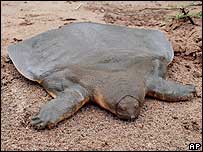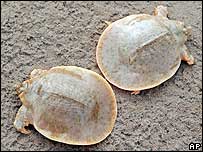Rare Giant Turtle Found
Posted by: Loren Coleman on May 17th, 2007
Rare giant turtle found in Mekong
One of the world’s largest turtles, said to be on the brink of extinction, has been found in abundance in a former Khmer Rouge stronghold in Cambodia.
The giant turtle has rubbery skin and a powerful bite
Conservationists discovered an 11kg (24lb) female Cantor’s giant soft-shell turtle and a nesting ground during a survey of the country’s Mekong River.
The species, which can grow two metres (6ft) long and weigh 50kg (110lb) was last spotted in Cambodia in 2003.
Scientists say the find could help save it from disappearing off the planet.
Experts from Conservation International (CI) and WWF, along with Cambodian wildlife officials, stumbled across the animal and the nesting ground when conducting a survey in March.
Rubbery skin
“We thought it might be almost gone but found it in abundance in this one pristine stretch of the Mekong, making the area the world’s most important site for saving this particular species,” David Emmett, a CI biologist said.
Eggs that were found have since hatched. The baby turtles were released into the wild earlier this month, along with another adult turtle.
The hatchlings were released along with an adult turtle
The species has a rubbery skin and a powerful bite, with jaws strong enough to crush bone.
It spends most of its time hidden in sand with only its eyes or nose showing.
Mr Emmett said the turtle could extend its neck with lightning speed.
“It has the fastest strike of any animal I’ve ever seen, including cobras.”
The region where the species were found had been closed to scientific exploration for many years because it was one of the last places under the control of the Khmer Rouge.
Mark Bezuijen of the WWF, who led the team, said the area was “a near pristine region of tall riverine forest, waterways and island archipelagos where further exciting biological discoveries will almost certainly be made”.
The conservationists plan to protect the turtles by employing local people to patrol the beaches.
They hope to prevent illegal fishing of the species, which is an expensive delicacy in Vietnam.BBC News
About Loren Coleman
Loren Coleman is one of the world’s leading cryptozoologists, some say “the” leading living cryptozoologist. Certainly, he is acknowledged as the current living American researcher and writer who has most popularized cryptozoology in the late 20th and early 21st centuries.
Starting his fieldwork and investigations in 1960, after traveling and trekking extensively in pursuit of cryptozoological mysteries, Coleman began writing to share his experiences in 1969. An honorary member of Ivan T. Sanderson’s Society for the Investigation of the Unexplained in the 1970s, Coleman has been bestowed with similar honorary memberships of the North Idaho College Cryptozoology Club in 1983, and in subsequent years, that of the British Columbia Scientific Cryptozoology Club, CryptoSafari International, and other international organizations. He was also a Life Member and Benefactor of the International Society of Cryptozoology (now-defunct).
Loren Coleman’s daily blog, as a member of the Cryptomundo Team, served as an ongoing avenue of communication for the ever-growing body of cryptozoo news from 2005 through 2013. He returned as an infrequent contributor beginning Halloween week of 2015.
Coleman is the founder in 2003, and current director of the International Cryptozoology Museum in Portland, Maine.












Fantastic news but i don’t like the term ‘found in abundance’. It portrays slightly that this means they’re not in the danger previously thought, but in reality the threat is still very real.
That’s not a giant turtle: THIS is a giant turtle (more about the prehistoric Archelon ischyros).
UKCryptid- I agree. By saying that they are in abundance, it kinds of downplays the very real danger this species could be facing. Obviously its habitat has diminished and it is hunted for its meat, so although in this area they may be doing fine, overall I think saying they are present “in abundance” really depends on the way one looks at it. I hope they are successful in patroling and protecting the area. I am quite interested in any other biological discoveries that turn up there.
I wonder if Hoan Kiem’s Cryptid Turtle in Vietnam is in fact one such 500 year old turtle.
Does anyone recall the very large softshell turtle carcass that was found floating in a Florida canal. It was huge. I had the picture saved, but must have lost it in a re-load. It seemed much larger then this turtle.
What they should do is collect a few and set up a captive breeding program. Then let the captive breeding program sell a few to people who want to set up commercial farming operations, like they farm alligators and crocodiles. If the meat is that expensive it should be commercially viable. Farming reptiles is somewhat easy because of the high reproductive rates they use to get around heavy predation on the young.
I could be wrong, but this looks like a different species than the Hoan Kiem turtle. The head looks somewhat different.
The thing looks a bit like Henodus…
It does look a bit like henodus, but those weren’t turtles, they were actually placodonts I believe.
Softshell Turtles( Family Trionychidae)
Four of 5 Species of Softshell Turtle are found in the Northern part of Vietnam, the Wattle-necked sofshell, the Asian Giant Softshell Turtle ( pelochelys cantorii) The Chinese softshell turtle, the Shanghai Softshell Turtle.A fifth species the Asiatic Softshell turtleLives in Central and southern lowlands.
Yes, Kamoeba, they were. I always found them so weird looking, I’m just surprised to see anything even close to it alive today…
According to Wikipedia’s “List of Megafauna Recently Discovered” the Hoan Kiem turtle is a different species – Rafetus leloii. It would be great if there are surviving members of that species as well.
The Sacred Turtles of Hoan Kiem Lake. In Hanoi, 660ft wide and 2300 ft long. Murky Green waters 6.5ft deep, polluted by urban runoff. Long thought to be the Asian Giant Softshell turtle (Pelochelys canttorrii). It is in fact a member of the softshell turtle genus RAFETUS. Scientists agree on its generic name, its status as a species is debated. Most believe that Hoan Kiem turtles are Shanghai Softshell Turtles based on shell morphology.The question of taxonomic identification cannot be solved until additional specimens become available. It could be a species new to science.
It is widely thought that viable populations of this species no longer exist in the wild.
Surveys taken in 2000 revealed small populations in the Northern provinces and they did find a juvenile specimen indicating that a population can still reproduce.
I could be mistaken but I thought there was only one specimen surviving in Hoan Kiem Lake and that there are some that think it is possibly the last of its kind. From what I understand, it is sort of a cryptid in its own right and rarely seen. I wasn’t aware that there are supposedly more in the lake or that its species had been determined.
I found where I heard this, it was from a proffesor Ha Dinh Duc, who is apparently one of the foremost experts on the biology of the lake. He believes that there is only one of the giant turtles remaining in the lake at present and that it could be the last of its kind.
Here is a link to an interesting article I found on the Hoan Kiem turtle.
http://www.asianturtlenetwork.org/library/news_articles/The_legend_of_the_Hoan_Kiem_Turtle.html
Mystery Man, it is unclear how many Hoan Kiem
live in the lake. recent estimates between one & three.Once seen on an average of four times a year, increased attention has brought sightings to around thirty annually.
It’s still uncertain where the Hoan Kiem turtles originated, they may have migrated from the red River when it was still connected to the lake 400 yrs ago.
Oh come on-it’s clearly a dead whale!
(Sorry-couldn’t resist it, given the other ‘Turtle’ thread!).
Bob Micheals- Interesting. I have read up on it a little and it does seem that no one knows for sure how many there are. Some think there are three, some think there are five. Proffesor Duc, who I mentioned, thinks there is only one, which can be identified by the white spot on its head and the leftward tilt as it swims. It doesn’t seem to be determined what exact species it is, or if it is a new species or not. Proffesor Duc seems to think it is a different species although similar to other species found in other parts of Vietnam. Very intrigueing mystery especially considering this lake is in a major urban area. This is one creature I hadn’t known much about, so your comments have urged me to look into it. Thank you very much for your fascinating input!
Mystery Man there is a dry specimen turtle in a temple on one of the two islands in the lake. The turtle died in the 1960s and was said to weigh 550 lbs, measured 5 ft in length, but since it was dry specimen it must have shrunk and should in a living specimen be a little larger.
Breed the turtle and save it from extinction.
Mystery Man, a new expedition is planned for June 2007, they hope to find additional new species in this pristine area of Cambodia.
Bob Michaels- Again, thanks for the info!